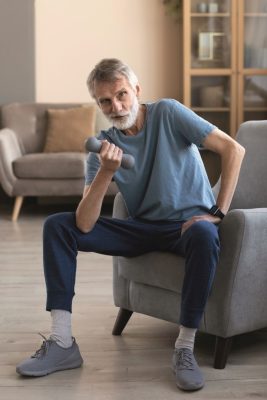Lack of exercise contributes greatly to the loss of quality of life and independence in old age, believes the South African Sports Medicine Association.
It says that regular exercise improves health and may prevent many non-communicable diseases, such as heart disease, diabetes, certain cancers, depression and even Alzheimer’s disease.
A study by the Human Performance Laboratory at Ball State University measured the heart and lung capacity and muscle fitness of people in their 70s who have been regular exercisers throughout their lives. The researchers found that the participants’ physical condition was comparable to people in their 40s.
TIP: When deciding where to retire, look for on-site or nearby walking trails and exercise facilities.
 No, don’t stand: Chair exercises count too!
No, don’t stand: Chair exercises count too!
Chair exercises allow people with balance or mobility challenges to exercise their lower body – and even their core and upper body – without standing up.
Choose a stable chair, preferably without armrests, and definitely without wheels. When you get started, be aware of your limitations. If an exercise causes you pain, stop doing it. You may want to check with your doctor about what exercise is suitable for you.
You can find wonderful chair exercises online (get someone to print a set out for you if you prefer). Before you begin, however, you must warm up. Do this by marching your feet for 30–60 seconds (simulated walking), then swinging your arms in slow circles 30 times. Repeat the feet and arm exercises for around three to five minutes.
Some physical activity is better than nothing!
The Heart and Stroke Foundation of South Africa has these helpful tips to make committing to regular exercise easier:
- Find a friend or family member to exercise with, and choose fun activities.
- Try listening to music while you exercise.
- Start slowly and set realistic goals.
- Remember to wear comfortable clothes and shoes.
- Park far from entrances to shopping centres to get your extra steps in.
- If you can, take the stairs instead of the lift.
- Gather your friends and organise a walk around the block, at a local park or along the beach.
- Play with your grandchildren.
- Get moving to your favourite music at home or join a dancing group.
- Swimming is easy on the joints and a wonderful way to keep fit.
Does movement really matter when you are older?
It has been proven in numerous studies that regular exercise improves overall well-being. Don’t believe us? Try it for yourself and see how much better you feel after a week.
Benefits include disease prevention (such as heart disease and diabetes, and improved immune function), improved mental health (exercise produces endorphins, also called the ‘feel-good’ hormone), decreased risk of falls (exercise improves strength and flexibility), and better brain function (there is evidence that exercise helps support cognitive ability).
S-t-r-e-t-c-h for better mobility and fewer aches
Stretching helps keeps spines, shoulders and necks more flexible, which improves posture and eases muscle tension and soreness.
A 12-month study published in the Journal of Gerontology showed that study participants who took part in the year-long stretching programme had decreased chronic pain and were physically fitter.
To get started, find some basic, simple stretches online. If you have balance issues, work near a table or have the backrest of a chair positioned nearby should you need to steady yourself.
You could also find a stretching and gentle exercise programme for older people in your community.


